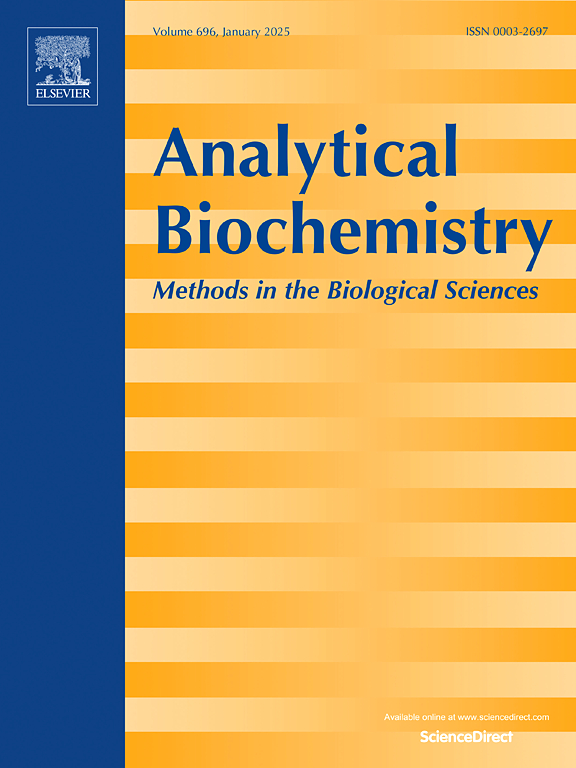Polyaniline-graphene oxide (PANI/GO)-grafted paper-based nanosensor for the detection of Helicobacter pylori
IF 2.5
4区 生物学
Q2 BIOCHEMICAL RESEARCH METHODS
引用次数: 0
Abstract
A polyaniline-graphene oxide (PANI-GO) nanocomposite-grafted DNA biosensor for detecting Helicobacter pylori-specific toxins, oncoprotein cytotoxin-associated gene A (CagA), has been reported. The nanocomposite was fabricated on Screen printed paper electrode (SPPE) and modified with a 5′NH2-labelled single-stranded DNA (ssDNA) probe specific to the CagA gene via an EDC/NHS cross-linker. Under optimized electrochemical experimental conditions, CV and DPV were used to analyse the performance of the developed biosensor. A linear dynamic range for H. pylori ssDNA was established between 0.00001 ng/μl and 0.1 ng/μl, with correlation coefficients of R2 = 0.9813 for the CV and R2 = 0.9343 for the DPV. The sensitivities of the developed sensor in the CV studies were 50.261 μA μL/ng∙mm2 and 66.5 μA μL/ng∙mm2 in the DPV studies. CV demonstrated an LOD of 0.0026 ng/μL, whereas the LOD of the DPV studies was 0.001 ng/μL. The developed sensor was validated using different concentrations of H. pylori ssDNA spiked in human stool samples. The results highlight the potential of the developed biosensor to detect and quantify H. pylori genomic DNA in a sensitive and reliable manner to aid in clinical diagnostics and pathogen detection applications.

聚苯胺-氧化石墨烯接枝纸基幽门螺杆菌检测传感器
一种聚苯胺-氧化石墨烯(聚苯胺-氧化石墨烯)纳米复合材料接枝的DNA生物传感器用于检测幽门螺杆菌特异性毒素——癌蛋白细胞毒素相关基因A (CagA)。该纳米复合材料在丝网印刷纸电极(SPPE)上制备,并通过EDC/NHS交联剂修饰CagA基因特异性的5 ' nh2标记单链DNA (ssDNA)探针。在优化的电化学实验条件下,利用CV和DPV对所研制的生物传感器的性能进行了分析。在0.00001 ~ 0.1 ng/μl范围内建立了幽门螺杆菌ssDNA的线性动态范围,CV和DPV的相关系数分别为R2 = 0.9813和R2 = 0.9343。所研制的传感器在CV研究中的灵敏度为50.261 μA μL/ng∙mm2,在DPV研究中的灵敏度为66.5 μA μL/ng∙mm2。CV的LOD为0.0026 ng/μL,而DPV的LOD为0.001 ng/μL。利用不同浓度的幽门螺杆菌ssDNA在人类粪便样本中进行了验证。这些结果突出了开发的生物传感器以敏感和可靠的方式检测和量化幽门螺杆菌基因组DNA的潜力,以帮助临床诊断和病原体检测应用。
本文章由计算机程序翻译,如有差异,请以英文原文为准。
求助全文
约1分钟内获得全文
求助全文
来源期刊

Analytical biochemistry
生物-分析化学
CiteScore
5.70
自引率
0.00%
发文量
283
审稿时长
44 days
期刊介绍:
The journal''s title Analytical Biochemistry: Methods in the Biological Sciences declares its broad scope: methods for the basic biological sciences that include biochemistry, molecular genetics, cell biology, proteomics, immunology, bioinformatics and wherever the frontiers of research take the field.
The emphasis is on methods from the strictly analytical to the more preparative that would include novel approaches to protein purification as well as improvements in cell and organ culture. The actual techniques are equally inclusive ranging from aptamers to zymology.
The journal has been particularly active in:
-Analytical techniques for biological molecules-
Aptamer selection and utilization-
Biosensors-
Chromatography-
Cloning, sequencing and mutagenesis-
Electrochemical methods-
Electrophoresis-
Enzyme characterization methods-
Immunological approaches-
Mass spectrometry of proteins and nucleic acids-
Metabolomics-
Nano level techniques-
Optical spectroscopy in all its forms.
The journal is reluctant to include most drug and strictly clinical studies as there are more suitable publication platforms for these types of papers.
 求助内容:
求助内容: 应助结果提醒方式:
应助结果提醒方式:


